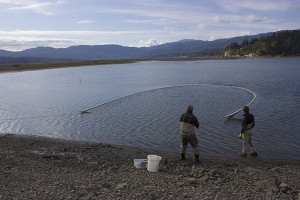
Source: Northwest Indian Fisheries Commission
The Jamestown S’Klallam Tribe is restoring salmon habitat in the 118-acre Washington Harbor by replacing a roadway and two culverts with a 600-foot-long bridge.
The 600-foot-long road and the two 6-foot-wide culverts restrict tidal flow to a 37-acre estuary within the harbor adjacent to Sequim Bay, blocking fish access and harming salmon habitat.
The Jamestown S’Klallam Tribe seined Washington Harbor to develop a baseline of fish populations in the harbor. The harbor’s roadway and two culverts will be replaced by a bridge later this summer. More photos can be found at NWIFC’s Flickr page by clicking on the photo.
The tribe seined the harbor in April to take stock of current fish populations before construction begins this summer. Chum and chinook and pink salmon, as well as coastal cutthroat, all use the estuary. Young salmon come from a number of streams, including nearby Jimmycomelately Creek at the head of Sequim Bay.
Historically, the area had quality tidal marsh and eelgrass habitat until the roadway and culverts were installed about 50 years ago, said Randy Johnson, Jamestown S’Klallam Tribe habitat program manager.
“The roadway and culverts appear to have severely degraded this habitat, with evidence showing that the estuary marsh has been deprived of sediment and is eroding,” he said. “The structures restrict access for fish and for high quality habitat to develop.”
